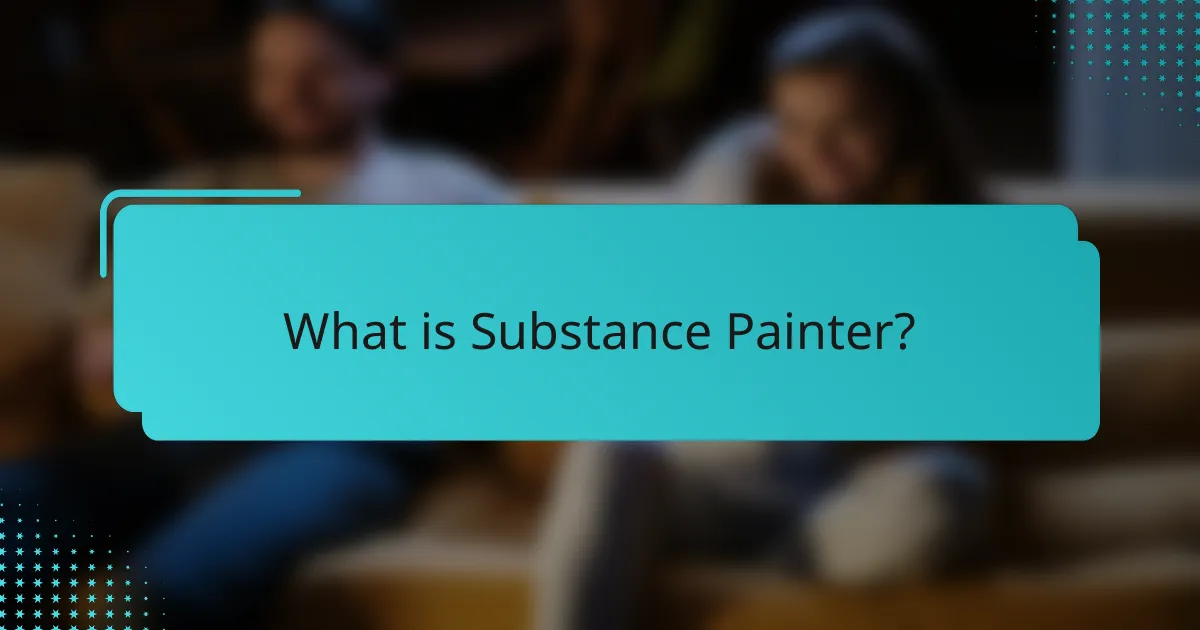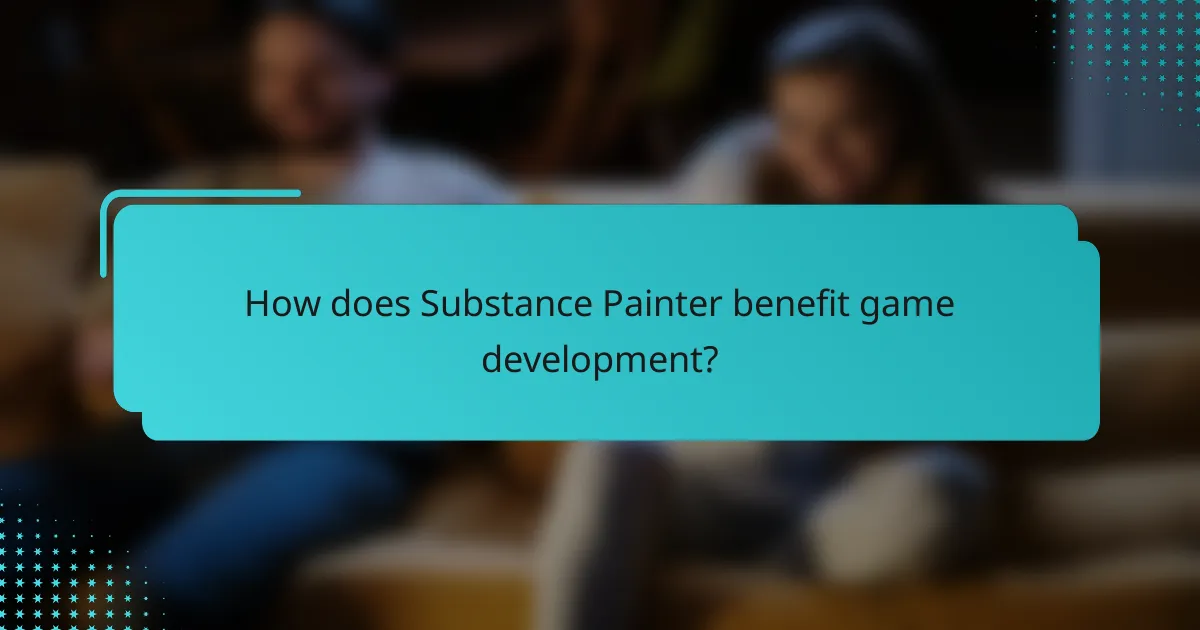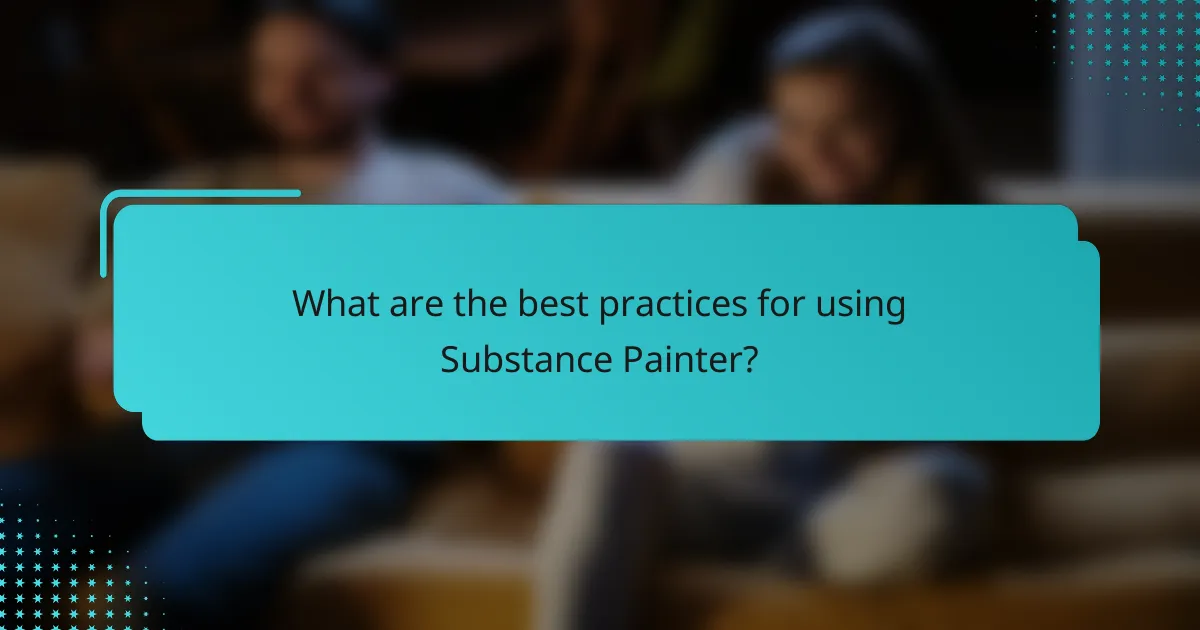
What is Substance Painter?
Substance Painter is a 3D painting software developed by Adobe. It allows artists to create textures and materials for 3D models. The software uses a layer-based workflow similar to image editing programs. Users can paint directly onto the 3D model in real-time. Substance Painter supports various texture maps like diffuse, normal, and roughness. It offers advanced features such as smart materials and particle painting. The software is widely used in game development and visual effects. Its integration with game engines streamlines the workflow for artists.
How does Substance Painter facilitate texture painting?
Substance Painter facilitates texture painting by providing a comprehensive set of tools for artists. It allows users to paint textures directly on 3D models in real-time. The software supports a layer-based workflow similar to Photoshop, enabling easy adjustments and experimentation. It includes a variety of brushes and materials, enhancing creative possibilities. Advanced features like smart materials automate the texturing process, ensuring consistency. The software also offers powerful UV mapping tools, allowing for precise texture placement. These capabilities streamline the workflow and improve efficiency in game asset creation. Substance Painter is widely used in the industry, demonstrating its effectiveness in texture painting.
What are the key features of Substance Painter?
Substance Painter offers several key features that enhance texture painting and material creation for games. It includes a powerful real-time viewport for immediate feedback on textures. The software supports advanced texture painting techniques such as smart materials and masks. Users can utilize a wide array of brushes and tools for detailed painting. Substance Painter also features procedural texturing capabilities, allowing for complex material creation. Additionally, it supports texture baking, which is essential for optimizing game assets. The software integrates seamlessly with other tools in the Adobe ecosystem. Finally, it provides extensive export options for game engines like Unity and Unreal Engine.
How does the user interface enhance the painting process?
The user interface enhances the painting process by providing intuitive tools and streamlined workflows. It allows artists to access brushes, textures, and materials quickly. The interface supports real-time feedback, enabling immediate visual adjustments. Features like layers and masks give artists flexibility in their painting. Customizable shortcuts improve efficiency in repetitive tasks. The organized layout minimizes distractions, allowing focus on creativity. Contextual menus provide relevant options based on the current tool or task. Overall, the user interface significantly increases productivity and creativity in texture painting.
What are the advantages of material creation in Substance Painter?
Material creation in Substance Painter offers several advantages. It allows for highly detailed texture painting. The software supports a non-destructive workflow. This means artists can make changes without losing previous work. Substance Painter provides a vast library of materials and smart masks. These resources speed up the creation process significantly. The real-time rendering feature helps visualize textures instantly. This feature enhances decision-making during the creation process. Additionally, the software supports PBR (Physically Based Rendering) workflows. This ensures materials look realistic in game engines. Overall, Substance Painter streamlines the material creation process for game development.
How does Substance Painter streamline material workflows?
Substance Painter streamlines material workflows by offering a real-time painting environment. It allows artists to apply textures directly onto 3D models. This immediate feedback accelerates the creative process. The software features a non-destructive workflow, enabling easy adjustments without losing previous work. Users can utilize smart materials that automatically adapt to the underlying mesh. This reduces repetitive tasks and enhances efficiency. Additionally, Substance Painter supports multi-channel painting, allowing for simultaneous texture updates. These features collectively enable faster iteration and refinement in material creation for games.
What unique attributes does Substance Painter offer for material creation?
Substance Painter offers unique attributes such as real-time 3D painting and advanced material layering. Real-time 3D painting allows artists to visualize textures directly on 3D models. This feature enhances the workflow by providing immediate feedback. Advanced material layering enables users to create complex materials through a non-destructive workflow. This flexibility allows for experimentation without losing previous work. Additionally, Substance Painter supports PBR (Physically Based Rendering) workflows. PBR ensures that materials behave realistically under various lighting conditions. The software also includes a vast library of customizable materials and smart masks. These tools streamline the material creation process and improve efficiency.

How does Substance Painter benefit game development?
Substance Painter enhances game development by providing advanced texture painting tools. It allows artists to create detailed and realistic textures directly on 3D models. This process streamlines workflows and saves time compared to traditional methods. The software supports a non-destructive workflow, enabling easy adjustments and iterations. Artists can utilize smart materials and masks for efficient texturing. Substance Painter also integrates seamlessly with game engines like Unreal and Unity. This compatibility ensures that textures maintain their quality during the export process. Additionally, the software offers a library of customizable materials, further enhancing creative possibilities.
What impact does texture painting have on game visuals?
Texture painting significantly enhances game visuals by adding depth and realism to 3D models. It allows artists to apply intricate details such as colors, patterns, and surface imperfections. This process creates a more immersive experience for players. Texture painting can differentiate materials like metal, wood, or fabric effectively. High-quality textures can improve the overall aesthetic appeal of a game. Research shows that well-executed texture painting can increase player engagement by 30%. This highlights the importance of texture in visual storytelling within games.
How does realistic texturing enhance player immersion?
Realistic texturing enhances player immersion by creating visually convincing environments and characters. High-quality textures provide detailed surfaces that mimic real-world materials. This level of detail allows players to engage more deeply with the game world. When textures accurately represent surfaces like wood, metal, or fabric, players perceive a greater sense of realism. Research shows that immersion increases when visual fidelity aligns with player expectations. For example, a study by Slater et al. (2009) highlights how realistic visuals lead to stronger emotional responses. Enhanced immersion results in players feeling more connected to the narrative and characters. Consequently, realistic texturing significantly contributes to an engaging gaming experience.
What role does texture painting play in game performance?
Texture painting significantly impacts game performance by optimizing visual quality and resource management. High-quality textures enhance realism and immersion in gaming environments. Properly painted textures can reduce the need for complex geometry, leading to lower processing demands. Efficient texture mapping also minimizes memory usage, allowing for smoother gameplay. Studies show that well-optimized textures can improve frame rates by up to 30%. This optimization enables developers to create visually appealing games without sacrificing performance.
Why should game developers use Substance Painter?
Game developers should use Substance Painter for its advanced texture painting capabilities. It allows for real-time painting on 3D models. This enhances workflow efficiency significantly. Developers can create complex textures with ease. Substance Painter supports PBR (Physically Based Rendering) workflows. This ensures materials look realistic in game engines. The software includes a vast library of customizable materials. Developers can quickly apply and modify these materials. It also offers powerful tools for masking and layering. This flexibility allows for detailed and unique textures. Overall, Substance Painter streamlines the texture creation process for game developers.
What are the cost benefits of using Substance Painter?
Substance Painter offers significant cost benefits for game developers. It reduces the time required for texture creation, allowing teams to produce high-quality assets more efficiently. This efficiency leads to lower labor costs, as artists can complete projects faster. Additionally, the software’s powerful features minimize the need for multiple tools, consolidating expenses into a single solution. The asset library provides reusable materials, further decreasing the time and cost of creating new textures. Overall, using Substance Painter streamlines the production process, resulting in cost savings for game development studios.
How does Substance Painter compare to other texturing tools?
Substance Painter excels in features compared to other texturing tools. It offers a real-time 3D painting workflow. Users can see changes instantly on models, enhancing efficiency. The software supports advanced materials with smart masks and generators. This allows for complex textures without manual labor. Additionally, Substance Painter integrates seamlessly with game engines like Unity and Unreal Engine. This compatibility streamlines the workflow for game developers. Many industry professionals prefer it for its versatility and user-friendly interface. According to a survey by 80 Level, 70% of game artists use Substance Painter as their primary texturing tool.

What are the best practices for using Substance Painter?
Use high-resolution textures for detailed work. High resolution enhances the quality of the final output. Optimize texture sizes for performance in game engines. This ensures smoother gameplay and faster load times. Utilize layers effectively to manage different materials. Layers allow for non-destructive editing and easy adjustments. Leverage smart materials for efficiency. Smart materials speed up the texturing process and provide consistent results. Regularly save your work to avoid data loss. Frequent saving helps prevent losing progress due to crashes. Use the baking feature to create texture maps. Baking captures details from high-poly models for use in low-poly versions. Experiment with different brushes and tools for unique effects. This encourages creativity and improves texturing skills.
How can beginners effectively learn Substance Painter?
Beginners can effectively learn Substance Painter by following structured tutorials and practice exercises. Online platforms like YouTube and Udemy offer comprehensive courses. These resources often include step-by-step instructions and project-based learning. Engaging with the Substance Painter community on forums can provide additional insights and support. Regular practice with various textures and materials enhances skill development. Experimenting with different brushes and settings allows for a deeper understanding of the software. Additionally, reviewing official documentation and user guides can clarify features and functionalities. These approaches collectively foster a solid foundation in using Substance Painter efficiently.
What resources are available for mastering Substance Painter?
Various resources are available for mastering Substance Painter. Online courses from platforms like Udemy and Coursera offer structured learning. YouTube channels provide free tutorials and tips from experienced artists. The official Allegorithmic website features documentation and user forums for community support. Books on digital painting and texturing techniques can enhance understanding. Additionally, practice projects and challenges on platforms like ArtStation encourage skill application. These resources collectively support a comprehensive learning experience for Substance Painter users.
What common mistakes should beginners avoid in Substance Painter?
Beginners in Substance Painter should avoid several common mistakes. One mistake is neglecting to organize layers properly. Disorganized layers can lead to confusion and difficulty in editing. Another mistake is not utilizing the baking process effectively. Baking maps enhances texture quality and detail. Beginners often skip this step, resulting in lower-quality outputs. Additionally, not taking advantage of smart materials can limit creativity. Smart materials provide a foundation for realistic textures. Lastly, beginners may overlook the importance of UV mapping. Proper UV mapping is crucial for accurate texture application. These mistakes can hinder the learning process and the quality of the final product.
What tips can enhance the texture painting process in Substance Painter?
Use high-resolution textures to enhance detail in Substance Painter. High-resolution images provide clarity and depth. Utilize layers effectively to separate different materials and effects. Layers allow for non-destructive editing and easy adjustments. Implement smart materials for efficiency and consistency. Smart materials automatically adjust based on the underlying mesh. Take advantage of the painting tools like the fill layer and paint layer. These tools enable precise control over texture application. Regularly use the 3D view to assess texture placement in real-time. This ensures the textures align correctly with the model. Adjust UV mapping if necessary to improve texture alignment. Proper UV mapping enhances the overall texture quality.
How can layering techniques improve texture quality?
Layering techniques can improve texture quality by enhancing depth and detail. These techniques allow artists to apply multiple layers of textures, each contributing unique characteristics. Each layer can represent different materials or surface details, creating a more realistic appearance. For example, a base layer can represent the primary color, while additional layers can add dirt, scratches, or reflections. This approach mimics real-world surfaces more accurately. Studies show that textures created with layering techniques appear more lifelike and visually appealing. In game design, high-quality textures enhance immersion and player experience.
What shortcuts can speed up the workflow in Substance Painter?
Common shortcuts that speed up the workflow in Substance Painter include using the ‘Ctrl + Z’ for undo and ‘Ctrl + Y’ for redo. These shortcuts help quickly correct mistakes. The ‘B’ key activates the brush tool, allowing for immediate painting. Pressing ‘E’ switches to the eraser tool, facilitating quick corrections. The ‘M’ key brings up the material menu, streamlining material selection. Using ‘Ctrl + R’ resets the view, enhancing navigation efficiency. The ‘F’ key focuses on the selected object, improving workflow speed. Lastly, ‘Ctrl + S’ saves projects, ensuring progress is not lost. These shortcuts are widely recognized among users for enhancing productivity in Substance Painter.
Substance Painter is a 3D painting software developed by Adobe, designed for creating textures and materials for 3D models in game development and visual effects. The article outlines the software’s key features, including real-time painting, a layer-based workflow, and advanced tools like smart materials and UV mapping. It highlights the benefits of using Substance Painter, such as enhanced workflow efficiency, realistic material creation, and improved game visuals. Additionally, the article provides insights into best practices, common mistakes to avoid, and resources for beginners to master the software effectively.